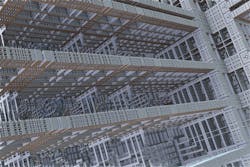US-government owned Tennessee Valley Authority (TVA) that supplies electrical power to parts of seven southeastern states has announced incentives related to the installation and use of germicidal ultraviolet lighting (UVGI — ultraviolet germicidal irradiation) in HVAC (heating, ventilation, and air conditioning) systems. The initiative is focused on UV-C-band (100‒280 nm) emission to deactivate the coronavirus and other pathogens in moving air and will target all public buildings from schools and hospitals to commercial offices and industrial facilities.
The coronavirus and the resultant COVID-19 disease has made UV-C disinfection a very hot topic across far more than magazines that cover the lighting space. If you need some background on the use of UV-C emission in germicidal applications, watch the archive of our recent webcast on the topic.
As the webcast reveals, most disinfection applications today are using legacy mercury-discharge UV-C lamps. Moreover, the interest level has led both Signify (Philips Lighting) and Osram to expand their manufacturing lines for such lamps. Long term, as output power and component lifetimes increase, UV-C LEDs will take over the UVGI application just as the solid-state lighting (SSL) components have usurped the general illumination application.
The deployment of UV-C technology in HVAC systems is compelling for two reasons. First, the most recent research has shown that the majority of coronavirus spread is through airborne transmission and the HVAC application can help stop that spread. Second, UV-C emission remains potentially dangerous to human skin and eyes, but burying the lamps inside ducting is perfectly safe. Indeed, one area where UV-C LEDs are being widely used is inside water pumps and even faucets.
The TVA, meanwhile, had posted a UVGI information resource page on its website that unfortunately appears to now be a broken link [as of Aug. 17, 2020]. That page has an animation that explains the benefits of UVGI in HVAC systems. The page suggests that for effective disinfection, such a system needs a 2-ft irradiation zone linearly inside a duct that can provide a 0.4-sec exposure to moving air. The utility said that such a design can deliver 96% disinfection rates. The incentive is $30 per ton of HVAC cooling capacity.
“As the largest public power provider in America, a key focus for TVA is helping to keep our children and the public safe by supporting technologies that are proven to kill viruses,” said Jason Snyder, manager, TVA EnergyRight. “Schools and businesses realize they need solutions to purify indoor air, and we want to help them install it as they reopen.”
The TVA has created the TVA Preferred Partners Network of HVAC professionals that can install such UVGI systems. While government owned, the TVA receives no taxpayer funding, instead relying on revenue from selling electricity. The utility services a region of 10 million people.
We believe that UV-C installation in HVAC systems is one UVGI application that is sure to expand quickly due to the efficacy of the application and the safety. And we have a feature article on the topic under development for a future issue. We could well see regulatory policy on public buildings mandate UV-C or some similar disinfection technology in HVAC systems.
We are, however, hearing through the grapevine that there is a severe shortage of UV-C lamps and LEDs in the supply chain. Most manufacturers are currently backordered. Unfortunately, many of those products may be targeted for disinfection products and systems that are far less safe than HVAC-based systems. And there remains to be many lessons learned among lighting manufacturers trying to service the UVGI space.
*Updated to remove broken link to TVA web page.
For up-to-the-minute LED and SSL updates, why not follow us on Twitter? You’ll find curated content and commentary, as well as information on industry events, webcasts, and surveys on our LinkedIn Company Page and our Facebook page.





